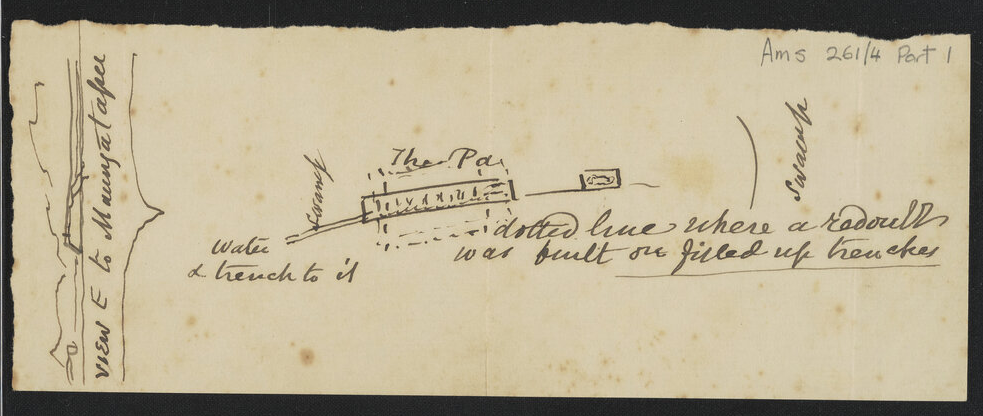From Tauranga City Library’s archives
A monthly blog about interesting items in our collection
The scribbles and scratches of Pablo Picasso are worth exorbitant amounts of money, such is the universal acclaim of the man. Not quite so universally acclaimed is our own Horatio Gordon Robley (1840-1932) who has attracted both admiration and ire. The admiration is mostly for his art and in particular his interest in tā moko. His 1896 published book “Moko; or Māori Tattooing” for example preserved much of this knowledge during a time when the practice was actively suppressed by Pākehā. But also ire, for the way we made a collection of preserved Māori heads from various shops and collectors in Europe during his retirement. A thesis by Tim Walker (Walker, 1985), of which we have a copy in our archives, has been an influential read in this space.
Ams 261 consists of the letter fragments by Robley writing
to the younger John Cuthbert Adams (1854-1932), former mayor of Tauranga
(1917-1919). Most locals will know Adams
from the ‘Adams Cottage’ on Adams Ave in Mount Maunganui
Series one mentions (among other interesting things)
his hasty sketching of trenches after the Battle at Pukehinahina (1864) to send
them on their way to The Illustrated London News, where they are published on
July 23. Robley had arrived in New Zealand as part of the 68th Durham Regiment
of Foot Light Infantry, tasked with securing it as part of the colonial
invasion of the Waikato and Bay of Plenty. His art, undertaken during the
actual conflict and immediately afterwards, is considered a contributing factor
to the public discontent with the war back in England
It’s interesting to note some of the differences between
this etching based on Robley's work, and his own watercolour (below). The etching back in London
has been interpreted to a degree. There is no dead or dying Toa in the etching
and no British carrying away the dead in the background. The watercolour seems
to show an understanding of the functions of the pa construction too. It
depicts dugouts coming off of the trenches, which played a crucial role in
protecting the defenders as they waited to spring the trap. The etching shows no
such awareness.
In series two, Robley refers to an event just before the
Battle at Pukehinahina, in which he had found time to go duck-shooting up the
Waimapu estuary with his guide, Raniera Te Hiahia. Never without a sketchpad,
he’d sketched the inland view to the south-west and put it away. Later during
the early part of the battle, when he saw from a frontal position, Māori
entrenching on Pukehinahina, he knew he was viewing from another angle one of
the ridges drawn in the sketch
Series three is a 1929 letter to Robley from an old soldier friend in the 68th and serving in Egypt. Robley has used the reverse to write to J.C. Adams, recalling how he ran to catch the coast steamer on April 30 to send sketches to the Illustrated London News and to inform family of his whereabouts.
Series four contains a sketch looking westward toward the
battle site Pa at Pukehinahina (at the top of this article). On the reverse is the view from the other side.
Series five includes a small newspaper cutting discussing the gifting of a photo of the pātaka of Tame Te Kapua to the Premier by Mr D. Asher and a letter referencing the work of Tregear, Edward (1846-1931), a prolific writer of the time. In 1891 Tregear published the Māori-Polynesian Comparative Dictionary.
Series six includes Gilbert Mair's notes on a Robley's
picture published by scholars Percy Smith and James Cowan and the final series
seven refers to Robley’s painful knee and his need to go about “on sticks”.
The papers are small and inconsequential looking, but we see in the illustrations dotted throughout, the mind of an artist fascinated with Māori design and art.
Pae Korokī is not a static thing, we need your help to
keep improving it. Here, for example, we often struggle to correctly transcribe
the handwriting. If you excel at reading difficult handwriting, pop into Pae
Korokī and click the “TEXT” button then “Transcription” where you can read our
efforts. You might be able to then “suggest an edit” using the button on the
top left of the page (it looks like a pen hovering over a piece of paper).
See also a "The Past and the Curious" video on this topic (May 4th, 2022)
Sources:Arabin, S. (2015). Adams Cottage, Mt Maunganui. Retrieved from Tauranga Historical Society and Brain Watkins House: http://taurangahistorical.blogspot.com/2015/07/adams-cottage-mt-maunganui.html
Melvin, L. (1957). Horatio
Gordon Robley, Soldier Artist in The Bay of Plenty 1864-1866 (edited version of
"Soldier with a Pencil"). Tauranga Historical Society (1990)
Engraver using Robley. (1864). The war in New Zealand - the conflict of April. Museum of New Zealand, Te Papa Tongarewa: https://collections.tepapa.govt.nz/object/224988
Ray, W. in Radio New Zealand's podcast "Black Sheep". Headhunter, the story of Horatio Robley
Robley, H. (1864). Breach
at Gate Pa, morning of April 30, 1864. Museum of New Zealand Te Papa
Tongarewa. https://collections.tepapa.govt.nz/object/139061
Simons, C. (2019). Soldiers, Scouts and Spies. Massey University Press
Tauranga City Libraries, Ams 261: https://paekoroki.tauranga.govt.nz/nodes/view/57267
The Illustrated
London News. (1864, July 23). Retrieved from Internet Archive:
https://archive.org/details/illustratedlondov45lond/page/80/mode/2up
Walker, T. (1985). Robley
: Te Ropere, 1840-1930, a thesis. Auckland: Auckland University
This archival item has been digitised and added to Pae Korokī. For more information about other items in our collection, visit Pae Korokī or email the Heritage & Research Team: Research@tauranga.govt.nz
Written by Harley Couper, Heritage Specialist at Tauranga City Library.




